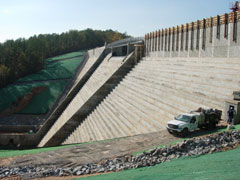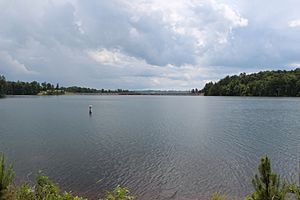Hickory Log Creek Dam facts for kids
The Hickory Log Creek Dam is a special type of dam called a gravity dam. It's built on Hickory Log Creek in Cherokee County, Georgia, USA. This creek flows into the Etowah River near Canton, Georgia, which is the county seat.
Since late 2007, there's been a special sensor, called a stream gauge, just below the dam. It helps measure the water levels. The area that drains water into the creek above the dam is about 8.33 square miles (21.6 square kilometers).
Contents
The Dam and Its Lake
The Hickory Log Creek Dam is about 180 feet (55 meters) tall. It's located just north of Canton's business area. The city of Canton worked with the Cobb County-Marietta Water Authority (CCMWA) to build this dam. The lake it creates, called Hickory Log Creek Reservoir, is a backup water source. It provides extra drinking water for the area, especially during dry times.
The dam is about 950 feet (290 meters) wide and 180 feet (55 meters) high. This makes it one of the biggest dams in Georgia not built by the United States Army Corps of Engineers or Georgia Power. Construction finished in December 2007. It took about two more years for the lake to fill up completely.
When full, the reservoir covers about 411 acres (1.66 square kilometers). It has about 15 miles (24 kilometers) of shoreline. It can hold around 6 billion US gallons (23 million cubic meters) of water. The dam is allowed to provide about 39 million US gallons (148,000 cubic meters) of water each day. This water is shared by Canton and the CCMWA. Besides the dam and lake, the project also includes a water intake, a pump station, and a pipeline to move water.
Building the lake meant that several miles of the creek were covered by water. Also, about 411 acres (1.66 square kilometers) of trees were cut down to make way for the lake. The lake also collects runoff (water flowing over the ground) from a nearby industrial park.
Working Together
The City of Canton and the CCMWA teamed up to make sure the region has enough water for a long time. They split the costs of the project: Canton paid 25% and CCMWA paid 75%. This is because Canton uses 25% of the water, and CCMWA uses 75%. CCMWA sells water to Cobb and parts of nearby counties like Paulding and Douglas. This project also moves water from one river basin to another.
The Pump Station
Hickory Log Creek isn't very big. So, the pump station helps by pulling water from the Etowah River. It then pumps this water into the Hickory Log Creek Reservoir. A large pipe, 54 inches (137 cm) wide, connects the river intake to the pump station. Then, another pipe, 42 inches (107 cm) wide and about a mile (1.6 km) long, carries the water from the pump station to the reservoir.
The pump station has powerful pumps. These pumps can move a lot of water, helping to fill the reservoir and keep it supplied. They are powered by strong electric motors.
How Water is Used
The reservoir adds to Canton's current water supply, which comes from the Etowah River. Water from the reservoir goes to Canton residents and to CCMWA's many customers in the area. Canton currently serves about 6,100 customers. The reservoir is expected to help Canton meet its water needs until 2050, even with more people moving into the area.
Water Challenges with Alabama
The dam project received a permit in 2004. This is because the water from Hickory Log Creek eventually flows into the Coosa River, then the Alabama River, and finally into Mobile Bay in Alabama. Even though the dam was almost finished in late 2007, the state of Alabama went to U.S. federal court. Alabama tried to make the Corps of Engineers cancel the permit. They wanted the project to be reviewed again, considering how it might affect Alabama's water supply.
This legal action was partly because Georgia was trying to keep more water during a drought. But it's also part of a bigger disagreement, often called the "tri-state water war." This water dispute between Georgia, Alabama, and Florida has been going on in court since 1990.
How the Dam Was Built
The dam was built using a special type of concrete called roller-compacted concrete (RCC). About 225,000 cubic yards (172,000 cubic meters) of RCC were used. The concrete was made right at the site. The materials for the concrete, like gravel and cement, came from nearby places. Fly ash was also added to the mix.
The concrete mix was moved to the dam using a conveyor belt system. One conveyor carried the mix up a hill to a transfer spot. From there, another conveyor moved the mix along the top of the dam. A special machine called a "tripper" then dropped the concrete where it was needed.
Once the RCC was dropped, bulldozers spread it out in layers about 12 inches (30 cm) thick. Smaller bulldozers were used at first, then larger ones as more concrete was placed. As the dam got taller, the conveyor system was raised using special hydraulic jacks. These jacks left openings in the concrete that help with drainage and air flow inside the dam.
After being spread, the RCC was pressed down tightly by large rollers. Smaller vibrating machines were used near the edges and around any openings.
The side of the dam that faces downstream is visible. To make it look nice, the construction team used a special method. They put a thin layer of grout (a type of cement mixture) on the surface. This made the dam's outer face smoother.
A lot of planning happened before building started. This included checking the dam site and designing the dam, pump station, and pipeline. During the design and building phases, the project was reviewed by the city, CCMWA, and the state's Environmental Protection Division.
Many Cranes Used
Because of where the dam was built, it was important to get materials and equipment to the construction crew exactly when needed. To do this, the team used four large cranes. They had cranes on different sides of the dam. They also used smaller cranes and lifts when needed. Having many cranes made it easy to lift heavy things anywhere on the dam.
Building the Walls
The dam has a flat, straight face on the upstream side (where the water collects). The downstream side (where the water flows out) has a stepped design. The steps on the downstream side were made using wood forms, creating steps about three feet (90 cm) high. On the upstream side, they used pre-made concrete panels. These panels were about 16 feet (4.9 meters) by 6.5 feet (2 meters) and 5 inches (13 cm) thick. They formed the outer face of the dam. Each panel had a special waterproof layer inside. These panels were made at a special yard on the construction site.
To hold these upstream panels in place while the concrete was being poured, permanent anchors were attached to the panels. These anchors went deep into the concrete. Temporary steel supports were also used on the outside for extra strength. About 1,100 of these panels were used in total.
The dam also has an inspection and drainage tunnel deep inside it. This tunnel is about 7 feet (2.1 meters) wide and 8 feet (2.4 meters) high. Its walls were formed using removable metal forms. The ceiling was made with pre-made concrete panels. Stairways were also built into the dam. These tunnels and passages make it easier to check the dam, drain water from its foundation, and inspect its inside.
Managing Temperature
Controlling temperature is important when building a dam, especially with a lot of roller-compacted concrete. When RCC dries, it creates heat. Too much heat can cause cracks.
To prevent overheating, the concrete was usually poured in the evening, starting around 5 PM. Work continued through the night and finished in the morning before it got too hot.
Temperature was also controlled because most of the gravel for the concrete was stored during the cold winter. The center of the gravel pile stayed cool, even when the weather warmed up. This helped keep the concrete mix cool. If the outside temperature got too high, the team could even add liquid nitrogen to the mix to cool it down more.
Temperature also helped decide if a special "bedding mortar" was needed between each layer of concrete. This mortar was used in a small area on the upstream side and at the ends of the dam each day. But it was only needed for the whole layer if the temperature and time between layers went over a certain limit.



